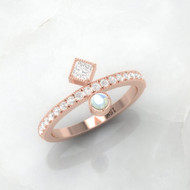Moonstone color.
21st May 2023
Moonstone's composition primarily consists of two types of feldspar minerals: orthoclase and albite. Orthoclase is a potassium aluminum silicate (KAlSi3O8), while albite is a sodium aluminum silicate (NaAlSi3O8). These minerals belong to the feldspar group, which is one of the most abundant mineral groups on Earth.

The distinctive optical properties of moonstone stem from its internal structure. Moonstone exhibits a phenomenon known as adularescence, which is the play of light caused by the reflection and scattering of light within the gemstone. This effect is due to the unique arrangement of orthoclase and albite feldspar layers within the crystal lattice.
The alternating layers of orthoclase and albite create thin, parallel planes or lamellae. These lamellae act as interfaces for light to enter and interact with the gemstone. As light enters the moonstone, it encounters these lamellae and undergoes diffraction, interference, and scattering processes.
The lamellae structure scatters the light in various directions, causing it to become dispersed and producing the characteristic glow or sheen. This phenomenon is most commonly observed as a bluish or white light that appears to move or float across the surface of the gemstone when viewed from different angles.
The size and arrangement of the lamellae within moonstone influence the intensity and color of the adularescent effect. Smaller and more closely spaced lamellae tend to create a stronger and more pronounced sheen, while larger and more widely spaced lamellae may result in a softer and less vibrant effect.
The specific composition and structure of moonstone give rise to its captivating adularescent glow, making it a unique and sought-after gemstone in the world of jewelry and gem enthusiasts.
Adularescence: The Phenomenon of Moonstone's Glow: Adularescence is the mesmerizing optical phenomenon exhibited by moonstone. It refers to the iridescent glow or sheen that appears to float beneath the surface of the gemstone. This ethereal effect is often compared to the soft glow of moonlight, giving moonstone its name.
The adularescent glow in moonstone is a result of the interaction between light and the internal structure of the gemstone. When light enters the moonstone, it encounters the alternating layers of orthoclase and albite feldspar minerals, which create thin lamellae within the crystal lattice.

As light passes through these lamellae, it undergoes diffraction, interference, and scattering. Diffraction occurs as the light waves bend and spread out when passing through the lamellae. Interference happens when the diffracted waves interact with each other, either reinforcing or canceling each other out.
The scattering of light within the moonstone's structure is responsible for the adularescent sheen. The scattered light waves reflect off the layers and exit the gemstone, creating a luminous glow that seems to move or float across the surface.
The intensity and color of the adularescent effect can vary depending on factors such as the size, orientation, and density of the lamellae. Moonstones with finer and more closely spaced lamellae tend to exhibit a stronger and more vibrant adularescence, while those with larger or more widely spaced lamellae may display a softer and less pronounced glow.
Adularescence is a captivating optical effect that sets moonstone apart from other gemstones. Its shimmering glow adds an enchanting and mystical quality to moonstone jewelry, making it a popular choice for those seeking a gemstone with a touch of ethereal beauty.

